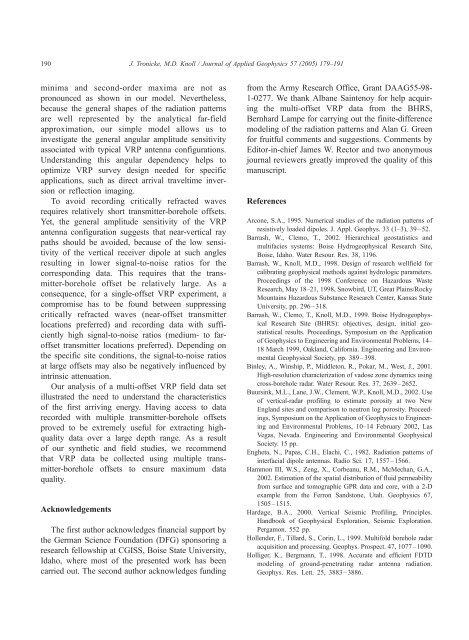Vertical radar profiling - CGISS - Boise State University
Vertical radar profiling - CGISS - Boise State University
Vertical radar profiling - CGISS - Boise State University
Create successful ePaper yourself
Turn your PDF publications into a flip-book with our unique Google optimized e-Paper software.
190<br />
J. Tronicke, M.D. Knoll / Journal of Applied Geophysics 57 (2005) 179–191<br />
minima and second-order maxima are not as<br />
pronounced as shown in our model. Nevertheless,<br />
because the general shapes of the radiation patterns<br />
are well represented by the analytical far-field<br />
approximation, our simple model allows us to<br />
investigate the general angular amplitude sensitivity<br />
associated with typical VRP antenna configurations.<br />
Understanding this angular dependency helps to<br />
optimize VRP survey design needed for specific<br />
applications, such as direct arrival traveltime inversion<br />
or reflection imaging.<br />
To avoid recording critically refracted waves<br />
requires relatively short transmitter-borehole offsets.<br />
Yet, the general amplitude sensitivity of the VRP<br />
antenna configuration suggests that near-vertical ray<br />
paths should be avoided, because of the low sensitivity<br />
of the vertical receiver dipole at such angles<br />
resulting in lower signal-to-noise ratios for the<br />
corresponding data. This requires that the transmitter-borehole<br />
offset be relatively large. As a<br />
consequence, for a single-offset VRP experiment, a<br />
compromise has to be found between suppressing<br />
critically refracted waves (near-offset transmitter<br />
locations preferred) and recording data with sufficiently<br />
high signal-to-noise ratios (medium- to faroffset<br />
transmitter locations preferred). Depending on<br />
the specific site conditions, the signal-to-noise ratios<br />
at large offsets may also be negatively influenced by<br />
intrinsic attenuation.<br />
Our analysis of a multi-offset VRP field data set<br />
illustrated the need to understand the characteristics<br />
of the first arriving energy. Having access to data<br />
recorded with multiple transmitter-borehole offsets<br />
proved to be extremely useful for extracting highquality<br />
data over a large depth range. As a result<br />
of our synthetic and field studies, we recommend<br />
that VRP data be collected using multiple transmitter-borehole<br />
offsets to ensure maximum data<br />
quality.<br />
Acknowledgements<br />
The first author acknowledges financial support by<br />
the German Science Foundation (DFG) sponsoring a<br />
research fellowship at <strong>CGISS</strong>, <strong>Boise</strong> <strong>State</strong> <strong>University</strong>,<br />
Idaho, where most of the presented work has been<br />
carried out. The second author acknowledges funding<br />
from the Army Research Office, Grant DAAG55-98-<br />
1-0277. We thank Albane Saintenoy for help acquiring<br />
the multi-offset VRP data from the BHRS,<br />
Bernhard Lampe for carrying out the finite-difference<br />
modeling of the radiation patterns and Alan G. Green<br />
for fruitful comments and suggestions. Comments by<br />
Editor-in-chief James W. Rector and two anonymous<br />
journal reviewers greatly improved the quality of this<br />
manuscript.<br />
References<br />
Arcone, S.A., 1995. Numerical studies of the radiation patterns of<br />
resistively loaded dipoles. J. Appl. Geophys. 33 (1–3), 39–52.<br />
Barrash, W., Clemo, T., 2002. Hierarchical geostatistics and<br />
multifacies systems: <strong>Boise</strong> Hydrogeophysical Research Site,<br />
<strong>Boise</strong>, Idaho. Water Resour. Res. 38, 1196.<br />
Barrash, W., Knoll, M.D., 1998. Design of research wellfield for<br />
calibrating geophysical methods against hydrologic parameters.<br />
Proceedings of the 1998 Conference on Hazardous Waste<br />
Research, May 18–21, 1998, Snowbird, UT, Great Plains/Rocky<br />
Mountains Hazardous Substance Research Center, Kansas <strong>State</strong><br />
<strong>University</strong>, pp. 296–318.<br />
Barrash, W., Clemo, T., Knoll, M.D., 1999. <strong>Boise</strong> Hydrogeophysical<br />
Research Site (BHRS): objectives, design, initial geostatistical<br />
results. Proceedings, Symposium on the Application<br />
of Geophysics to Engineering and Environmental Problems, 14–<br />
18 March 1999, Oakland, California. Engineering and Environmental<br />
Geophysical Society, pp. 389–398.<br />
Binley, A., Winship, P., Middleton, R., Pokar, M., West, J., 2001.<br />
High-resolution characterization of vadose zone dynamics using<br />
cross-borehole <strong>radar</strong>. Water Resour. Res. 37, 2639–2652.<br />
Buursink, M.L., Lane, J.W., Clement, W.P., Knoll, M.D., 2002. Use<br />
of vertical-<strong>radar</strong> <strong>profiling</strong> to estimate porosity at two New<br />
England sites and comparison to neutron log porosity. Proceedings,<br />
Symposium on the Application of Geophysics to Engineering<br />
and Environmental Problems, 10–14 February 2002, Las<br />
Vegas, Nevada. Engineering and Environmental Geophysical<br />
Society. 15 pp.<br />
Engheta, N., Papas, C.H., Elachi, C., 1982. Radiation patterns of<br />
interfacial dipole antennas. Radio Sci. 17, 1557–1566.<br />
Hammon III, W.S., Zeng, X., Corbeanu, R.M., McMechan, G.A.,<br />
2002. Estimation of the spatial distribution of fluid permeability<br />
from surface and tomographic GPR data and core, with a 2-D<br />
example from the Ferron Sandstone, Utah. Geophysics 67,<br />
1505–1515.<br />
Hardage, B.A., 2000. <strong>Vertical</strong> Seismic Profiling, Principles.<br />
Handbook of Geophysical Exploration, Seismic Exploration.<br />
Pergamon. 552 pp.<br />
Hollender, F., Tillard, S., Corin, L., 1999. Multifold borehole <strong>radar</strong><br />
acquisition and processing. Geophys. Prospect. 47, 1077–1090.<br />
Holliger, K., Bergmann, T., 1998. Accurate and efficient FDTD<br />
modeling of ground-penetrating <strong>radar</strong> antenna radiation.<br />
Geophys. Res. Lett. 25, 3883–3886.
















